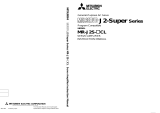
A - 3
4. Additional instructions
The following instructions should also be fully noted. Incorrect handling may cause a fault, injury, electric shock,
etc.
(1) Transportation and installation
CAUTION
Carry the products in a suitable way according to their weights.
Do not stack the product packages exceeding the maximum number specified on the package.
Do not hold the lead of the built-in regenerative resistor, the cables, or the connectors when carrying the
servo amplifier. Otherwise, it may drop.
Do not hold the cable, the shaft or the encoder when carrying the servo motor.
Install the equipment on a weight-bearing place in accordance with this Instruction Manual.
Do not get on or place heavy objects on the equipment.
Install the equipment in the specified direction. Improper installation causes oil leakage, leading to a fire
and malfunction.
Leave specified clearances between the servo amplifier and inner wall of the control box or other
equipment.
Do not block the intake/exhaust ports of the servo amplifier. Otherwise, a fault may occur.
Do not install or operate a servo amplifier and a servo motor which are damaged or have any part missing.
Do not drop or shock the servo amplifier or the servo motor as they are precision equipment.
When storing the equipment, please fulfill the following environmental conditions.
Item
Environmental
Servo amplifier Servo motor
Ambient
temperature
Operation [ ] 0 to 55 (non-freezing) 0 to 40 (non-freezing)
Storage [ ] 20 to 65 (non-freezing) 15 to 70 (non-freezing)
Ambient
humidity
Operation
5%RH to 90%RH (non-condensing)
10%RH to 80%RH (non-condensing)
Storage 10%RH to 90%RH (non-condensing)
Ambience Indoors (no direct sunlight) Free from corrosive gas, flammable gas, oil mist, dust and dirt
Altitude Max. 1000m (3280 ft)
Vibration resistance
5.9 m/s
2
, 10 to 55Hz
(directions of X, Y, and Z axes)
HF-KN Series
X
Y: 49m/s
2
HF-KP Series (Note)
HG-KR series (Note)
Note. For the standard servo motor (without reduction gear.)
Couple the servo motor to a machine securely. Insecure coupling may cause the servo motor to come off.
Be sure to measure the motor vibration level with the servo motor mounted to the machine when checking
the vibration level. A great vibration may cause the early damage of a bearing, encoder, brake, and
reduction gear. The great vibration may also cause the poor connector connection or bolt looseness.
For the gain adjustment at the equipment startup, check the torque waveform and the speed waveform by
using a measurement device, and then check that no vibration occurs. If the vibration occurs due to high
gain, the vibration may cause the early damage of the servo motor.
Take safety measures, e.g. provide covers, to prevent accidental access to the rotating parts of the servo
motor during operation.
Never hit the servo motor or shaft, especially when coupling the servo motor to a machine as it may
damage the encoder.
Do not apply load exceeding the permissible load as it may break the shaft.
When the equipment has been stored for an extended period of time, contact your local sales office.
When handling the servo amplifier, be careful with the edged parts such as the corners of the servo
amplifier.






















